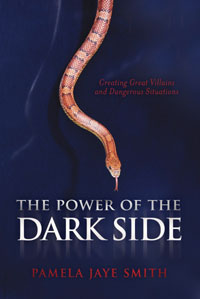
The Power of the Dark Side
INTRODUCTION
Conflict lies at the heart of all effective stories.
Every good story requires three basic conflicts: the hero’s internal flaw, an antagonist, and an external threat to the hero. These all need to be appropriate, balanced, believable, and capable of contributing to a satisfactory resolution. Ineffectiveness in these elements of conflict is one of the biggest problems story-tellers have. That ineffectiveness can be the result of many things:
- from naivete (it’s all good), to cynicism (it’s all bad)
- from making it too hard on the hero, to not hard enough
- from an ineffective antagonist, to one who overpowers the story
- from letting your message overpower the story, to having no message at all
- from inappropriately mixing one’s personal problems with the hero’s, to a lack of any believable human relevance
- from focusing on the hero’s personal conflict to the exclusion of its universality, or vice versa
- plus many more individually unique barriers to building great conflict
There are two essential qualities of good stories, Familiarity and Surprise. The clever writer will use universally familiar concepts and principles (mythic themes, archetypes, and imagery) and give them a unique, surprising spin to entertain and enlighten us anew with the universal truths around which wonder and recognition circle in delight.
Three must-have aspects of good stories are Sympathy, Danger, and Salvation. We must have Sympathy for and interest in the protagonist; the protagonist must be placed in Danger; there must be some sort of Salvation, direct or implied, for a satisfactory (not necessarily happy) resolution.
You must never make it easy for your protagonist. Barriers, setbacks, detours, and delays are the stuff of drama. Selecting and developing effective conflict requires knowledge of the so-called Dark Side – all that which stands in the way of their desires and fulfillment.
To assist you in crafting your stories, this book will:
- Examine various perspectives on Evil and the Dark Side to widen and deepen your choices for selecting and creating characters and their conflicts
- Define the Three Levels of the Dark Side: what they are, how they work, how to create characters and situations with them
- Examine Antagonists: antiheroes, evil-doers, seducers, bumblers, vampires, ghosts, aliens, etc. so you can more fully and believably develop those characters
- Investigate the Lure of the Dark Side, so your plots and actions are organic to your characters and stories
- Explore options your protagonist can use to confront, counteract, and defeat the Dark Side
But I’m writing a comedy, romance, children’s fantasy, or documentary…
Since conflict is the very heart of story, these principles apply in any style, any genre.
The Dark Side is there in comedies: Dr. Evil and Mini-Me in Austin Powers, Cold War cartoon spies Boris and Natasha in the Bullwinkle TV series, and Cruella DeVil of dalmation deviousness. Evil may not always pay, but sometimes it can be awfully funny.
Stories most popular with children have some seriously evil villains and deadly dangerous situations: Harry Potter, Grimm’s Fairy Tales, Star Wars. Developing young minds require a sense of meaning, self importance, and optimism; the way heroes in these stories deal with the Dark Side offers insight and encouragement for the dangers inherent in any child’s existence.
In romance stories the Dark Side is whatever comes between lovers, be it family fueds in Romeo and Juliet, 19th century English societal barriers in Pride and Prejudice, or selfish indecisiveness in My Best Friend’s Wedding.
Documentaries are only interesting and effective if there is some “us against them” element. Whether Them is the environment, a bureaucracy, a disease, or a situation, you will only engage our interest and stir our actions if you show us conflict and choices.
Fairy tales, comedy, romantic comedy, black comedy, drama, action-adventure, horror, tragedy, historical fiction, documentaries… all need worthy opponents, dangers to heroines, and the opportunity for your audience to observe and experience transformation as the story moves through conflict to resolution.
No matter the medium – from a theatrical blockbuster to a YouTube short, a massively multiplayer online game, or a torrid romance novel – without vivid and believable antagonists and threatening situations, there can be no heroics (whether of the heart or the sword), and hence no real story.
Conclusion
Conflict is the very heart and soul of drama, and the Dark Side offers worlds of conflict. Enjoy the exploration, add your own insights along the way to enhance the information, and use the suggestions to strengthen and expand your own skills and experience.
Put The Power of Dark Side to work on your side to write and create Great Villains, Dangerous Situations, and Dramatic Conflicts to entertain and enlighten us all!

View the Table of Contents
Read the Endorsements
Buy the relevant CD/Tape on
The Power of the Dark Side
Buy the Book here
Twenty ($20) dollars, plus Shipping and Handling ($5) = Total Twenty-five Dollars ($25)
| MAIL-IN ORDER FORM! |
